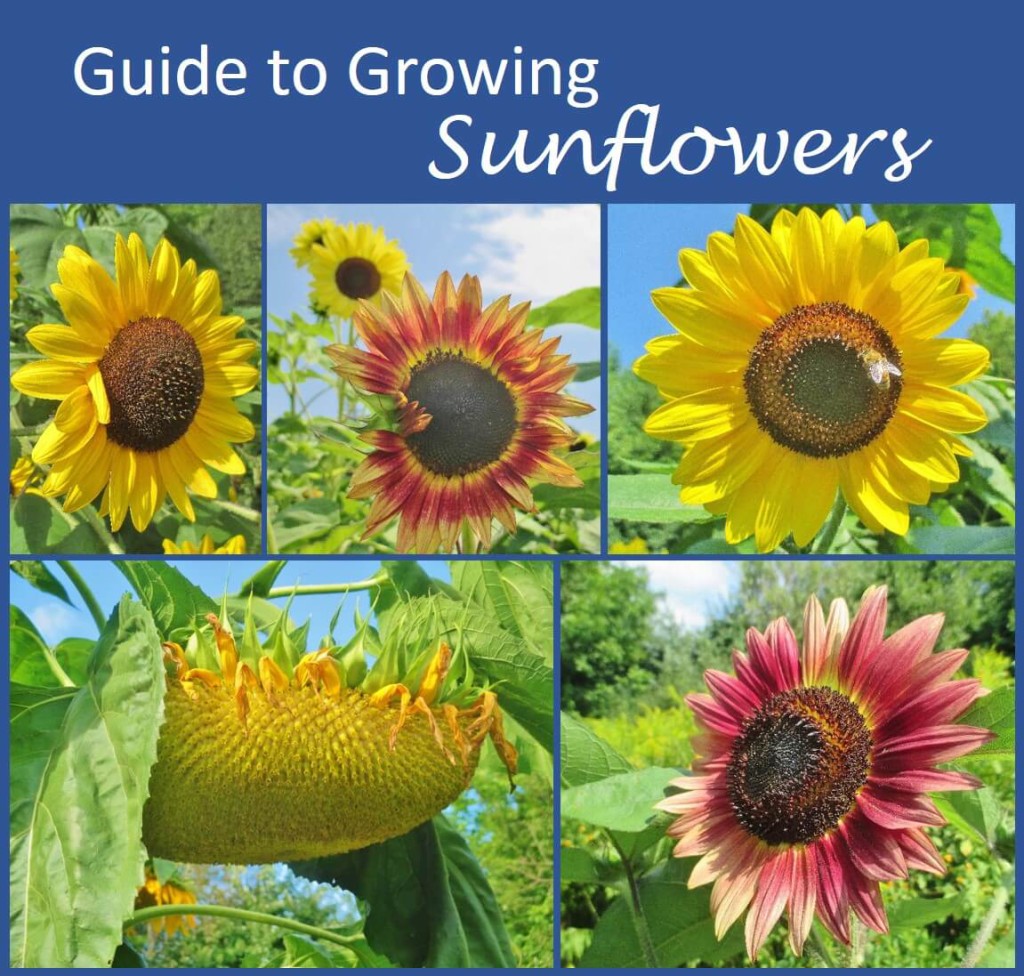
Learn to grow spectacular sunflowers for their beauty, wildlife value, and/or delicious snacks.
It wouldn’t be summer without big, bright beautiful sunflowers. Every year I await the sunny blooms with great anticipation, and when the flowers whither and seeds ripen, I enjoy watching chickadees and goldfinches flit around seed heads, and my chickens feasting on the toppled ones. Here you’ll learn how to grow sunflowers, how they are pollinated, how to choose a variety, and how to deal with common problems. You, too, can succeed with this American native, whether you’re interested in ornamental qualities, wildlife value, or a tasty snack.
Guide To Growing Sunflowers
Just a bit of history, first. The sunflower (Helianthus annus) is the only seed crop which was domesticated from an American native, and for me, that is reason enough to grow it. Native plants support native pollinators. Learn more about supporting native pollinators in Gardening for Pollinators. The wild annual sunflower is usually highly branched, producing many small seed heads, and reaching 10 feet in height. Domestication of this plant began about 3,000 years ago. The Spaniards brought it to Europe in 1510, but there was little interest in it until the late 1800’s, when the Russians began a selective breeding program to increase the oil content of sunflower seeds. Sunflower breeding is an ongoing endeavor, and modern hybrids yield more seeds and resist some of the pests and diseases, as you will see below.
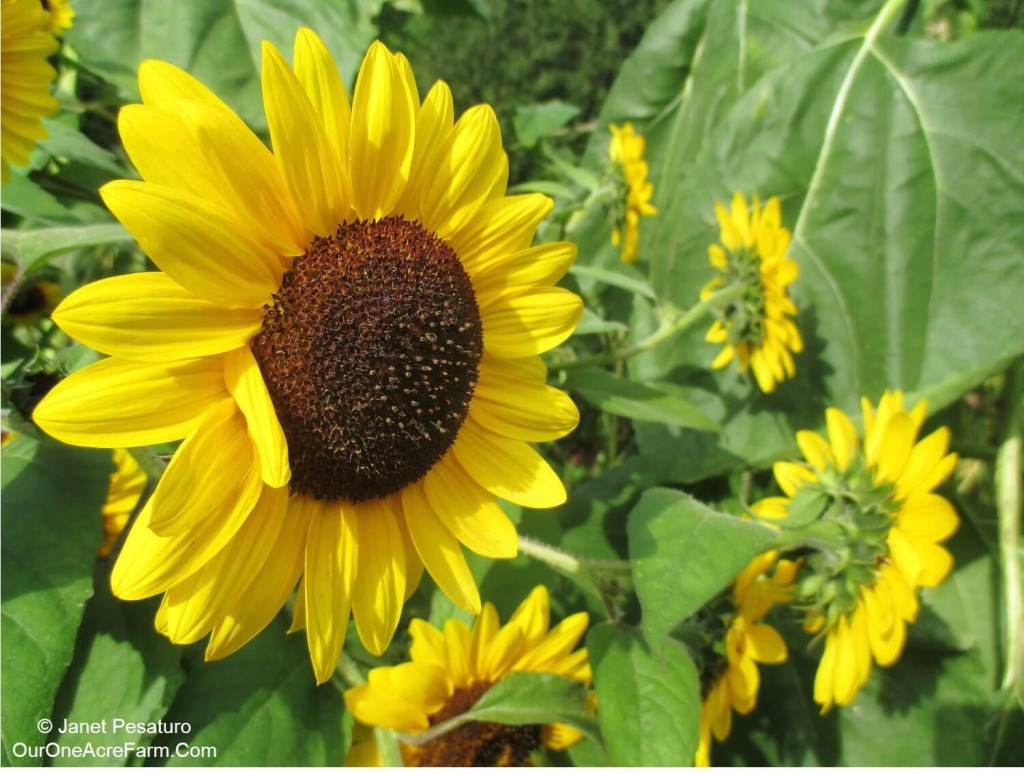
The multi-branched habit and smallish yellow flowers of this hybrid sunflower, make it similar in appearance to the native wild sunflower.
Common problems growing sunflowers
While sunflowers are easy to grow, many people complain “I can’t grow them”, and typically describe one or more of the following problems:
- Seedlings are cut or chewed off shortly after germination
- Mature plants are small and poor
- The season is too short for seed production
- Many of the seeds are empty hulls (poor pollination)
- Seed production in the center of the head is poor
- Wild birds and mammals steal the seeds
- A variety of insect pests and diseases
Read on, and you will learn more about these problems and their solutions.
This post contains links to online shopping, which is a way for you to support One Acre Farm at no additional cost to you. Click here for my full affiliate disclosure. Thanks for your support!
Growing conditions
It’s often said that sunflowers are drought tolerant plants that can adapt to a range of soil types. This is true: A long tap root allows the sunflower to harness water and nutrients several feet below the surface of the ground. But this is misleading for the gardener hoping for big beautiful plants with seed packed heads. Sunflowers grown in poor, dry soil will be scrawny plants with small seed heads. To reach its potential in size and seed production, a sunflower needs fertile soil, regular watering, and a pH of 6.0-7.5. Before planting, we enrich the soil with compost made from, among other organic material, poop from our chickens. Sometimes I side dress with a little more compost in mid-summer, or fertilize with manure tea or compost tea periodically throughout the season. I’m not scientific about the timing or quantity, and our sunflowers always do well.
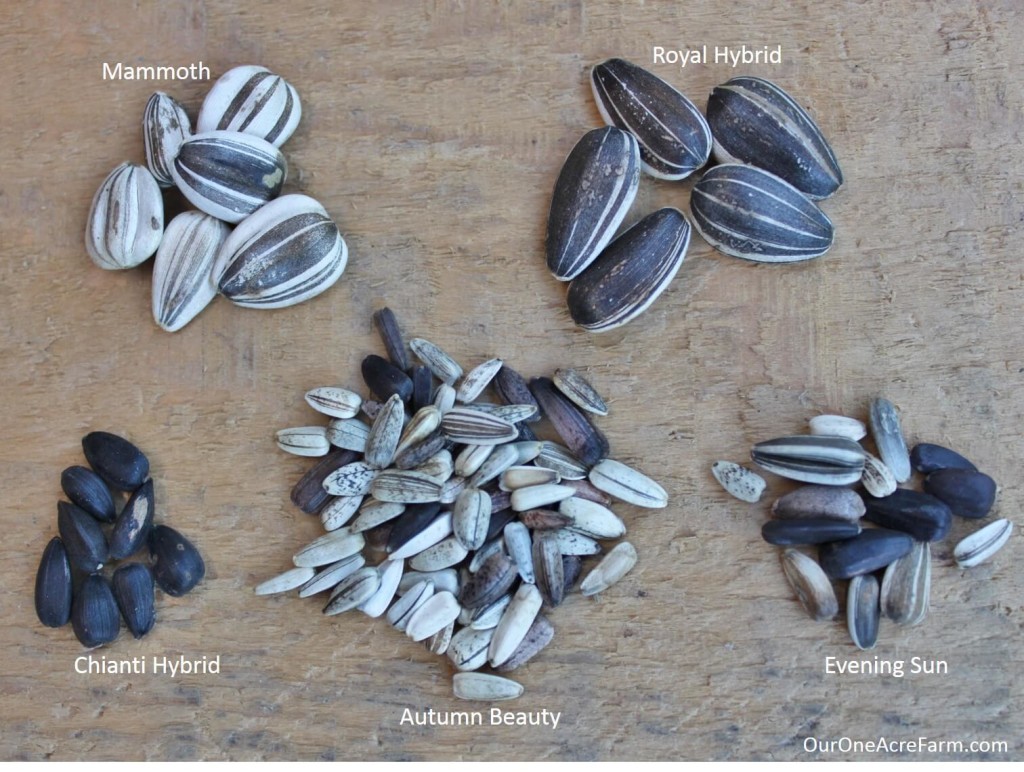
Seeds of several varieties of sunflower
Planting sunflower seeds
Most sunflower varieties need 95-110 frost-free days to produce mature seeds, which means they can grow in zone 5 and warmer. Conventional wisdom says that the seeds should be either direct seeded after danger of frost, or, in short season regions, started in pots a few weeks earlier, for later transplanting. But experience tells me that neither of those strategies is ideal for slowly maturing varieties (such as giant sunflowers) in short season regions. Here’s why:
- Direct seeding after danger of frost leaves a short growing season, sometimes too short.
- Transplanted seedlings sometimes grow up into stunted plants. This is probably a result of confining or damaging the long tap root.
So, I direct seed my sunflowers up to 4 weeks before the last frost date. Yes, sunflower seedlings are actually frost hardy. I learned this from watching so many early volunteer sunflower seedlings survive frost. For giant sunflowers, I usually plant groups of 5 seeds spaced 18-36 inches apart. For smaller, branched sunflowers, I plant one seed every 1-3 inches, in rows spaced 12 inches apart.
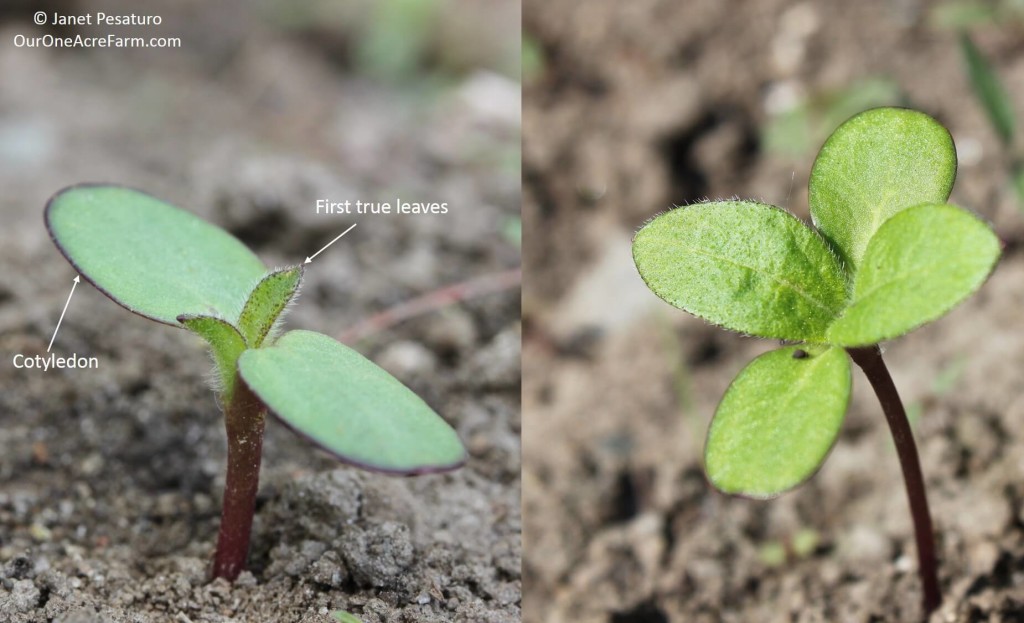
With its first true leaves just emerging, the seedling on the left still needs protection from birds, which love the embryonic cotyledons. The seedling on the right has well developed true leaves, and no longer needs protection from birds.
Protecting sunflower seedlings
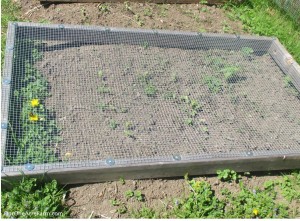
This hardware cloth sifter protects young seedlings from birds
Once you plant the seeds, you need to worry about critters eating those first leaves that emerge from the seed – the cotyledons, or embryonic leaves. Slugs, rodents, rabbits, deer, and birds are all thought to relish newly sprouted sunflower seeds, so you will need to protect them accordingly. You might need:
- Snail bait
- Cutworm cuffs
- Netting or other barrier
Our problem was birds eating the cotyledons, so we exclude birds by placing our hardware cloth sifters over the sunflower beds (see photo). Do not remove these barriers until the first true leaves are well developed.
Thinning the seedlings and supporting growth
- Thin by cutting/pinching, not pulling. Thin gradually, over the course of weeks, to select the most vigorous seedlings each time.
- Thin giant varieties ultimately to one plant per group, and smaller varieties to one plant per foot. Dwarf varieties can be grown more closely together.
- Water during dry spells, and fertilize with compost tea about once a week, or a side application of compost once or twice, for robust plants with large seed heads.
- Mulch them to keep down weeds and retain moisture. (I often mulch with the poop laden hay from my chicken runs. That’s an effective mulch AND fertilizer.)
- You might want to stake tall varieties, especially single flowered varieties expected to develop very large seed heads. My experience has been that about half of them topple if I don’t stake them.

Sunflowers are called composite flowers because they are composed of many smaller florets. The florets open in spiral fashion from the periphery inwards. Notice that the bee is feeding from florets in the male phase. That’s a common observation, and it’s because nectar production is highest and pollen is released during the male phase.
Understanding sunflower pollination
As members of the aster family, sunflowers are composite flowers, meaning that the “head” (what most people know as the flower) is composed of many smaller flowers called florets. Sunflowers have 2 types of florets:
- Ray florets, which most people know as the petals. These are sterile, meaning that they contain neither pollen nor an ovary, and cannot set seed. The purpose of ray florets is to attract pollinating insects.
- Disc florets which usually have fertile female and male parts.
To set seed, old fashioned sunflowers need insects to carry pollen from one plant to another. Many hybrids are more self-fertile, and the most modern commercial hybrids are fully self-fertile and self-pollinating. Each floret is open for at least 2 days. On day 1, only the male part is fertile (meaning that pollen is released). Nectar production is highest when the male part is fertile. On day 2, only the female part is fertile (meaning that the pistil is receptive to pollen). The result is that individual florets are not likely to self-pollinate.
If you’ve grown sunflowers, you might have noticed that the disc florets open from the periphery inwards. So, for most of the flowering period, a head has closed florets in the center of the disc, surrounded by a ring of florets in the male stage, then a ring of florets in the female stage. Watch the bees visiting a sunflower, and you will notice that they prefer the florets just beginning to open around the center of closed florets. That’s because they are in the male phase, when nectar production is highest and pollen is being released.
An interesting consequence of this pattern of opening from the periphery inwards, is that there is less and less pollen available to fertilize the remaining florets. This is why seed production is poorest in the central part of the disc.
Honeybees are the most important sunflower pollinators in terms of sheer number, but many species visit sunflowers, and bumblebees are the most effective sunflower pollinators. Temperature, humidity, and precipitation can all affect insect activity, so poor weather can mean poor seed production.
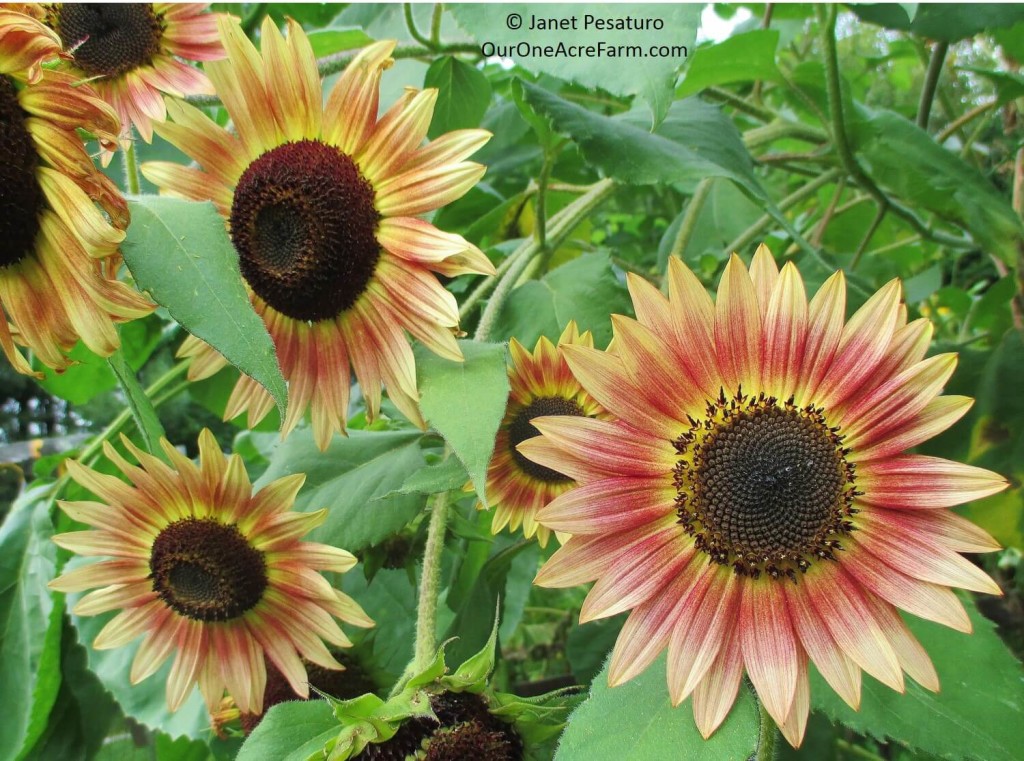
The gorgeous bi-color sunflower was from the mix, Autumn Beauty
Sunflower varieties
Hybrid sunflowers have replaced the wild sunflower for several reasons:
- Less dependence upon insect pollinators
- Better pest resistance
- Better seed yield
- Stronger stalks
- Uniformity in growth habit
- Desirable ornamental characteristics, including pollenless, double, colored, bi-colored, and dwarf.
Some hybrids are somewhat self-fertile, but produce seeds in greater number and of greater size and better quality in the presence of insect pollinators. Though I have read conflicting reports, I believe Mammoth Russian is one such variety. I have grown it many times. Sometimes seed production is poor and sometimes moderate. Because seed production is never excellent, I don’t think it is fully self-fertile nor fully self-pollinating.
Some modern commercial hybrids are fully self-fertile and self-pollinating. This means that the quantity and quality of seed production are excellent even in the absence of insect pollinators. One example is Royal Hybrid, available from Johnny’s Selected Seeds, which I am growing this year. I have grown this in the past and it produces much better than Mammoth Russian. Grow a modern hybrid if you don’t want to chance poor seed production.
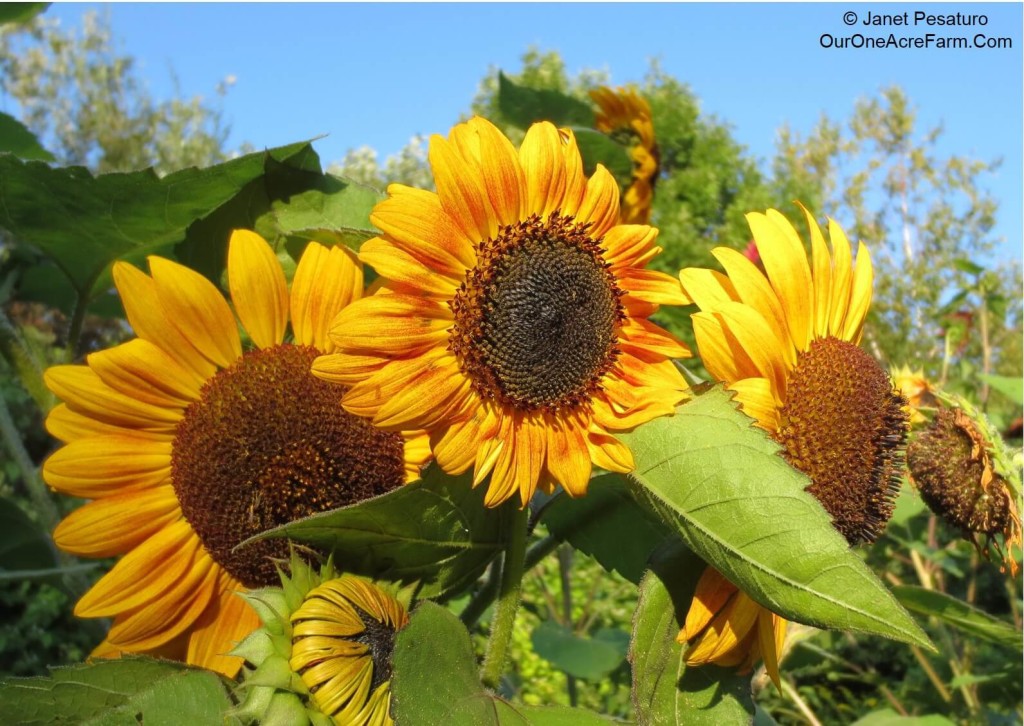
This stunning bi-color sunflower was from the mix Evening Sun.
Male-sterile varieties are pollenless, but the female parts can be pollinated by insects if pollen producing sunflowers are growing nearby. These hybrids do offer nectar for bees, but no pollen, so they are less valuable to insects overall. People like them for cut flowers, because they don’t drop pollen all over the furniture. Sunrich and Pro Cut are popular pollenless sunflower varieties.
Double-flowering sunflowers have disc florets with fluffy yellow petal-like material, but fertile disc florets they are, not sterile ray florets. Seed production may be poor (it’s always poor when I grow them) because it’s difficult for pollinating insects to reach the nectar and pollen. Of course that also means that double flowering sunflowers are a less valuable food source for pollinators. Teddy Bear and Giant Sun Gold are double varieties.
Fancy colored varieties sunflower come in shades of bronze, red, orange, pale yellow, near-white, and bi-color. Chianti is a beautiful deep wine red variety, and Lemon Queen is a lovely pale yellow. Autumn Beauty and Evening Sun are spectacular mixes of various colors and bi-colors. I grow one of those mixes almost every year, always with great success. Most of the plants in these mixes are branched, producing several small seed head. Goldfinches and chickadees love the small seeds.
Dwarf sunflowers grow less than 3 and 1/2 feet tall. Teddy Bear is a dwarf double flowering variety, Firecracker is a colorful mix of dwarf sunflowers, and Big Smile is a 1-2 feet tall variety with classic single yellow flowers.
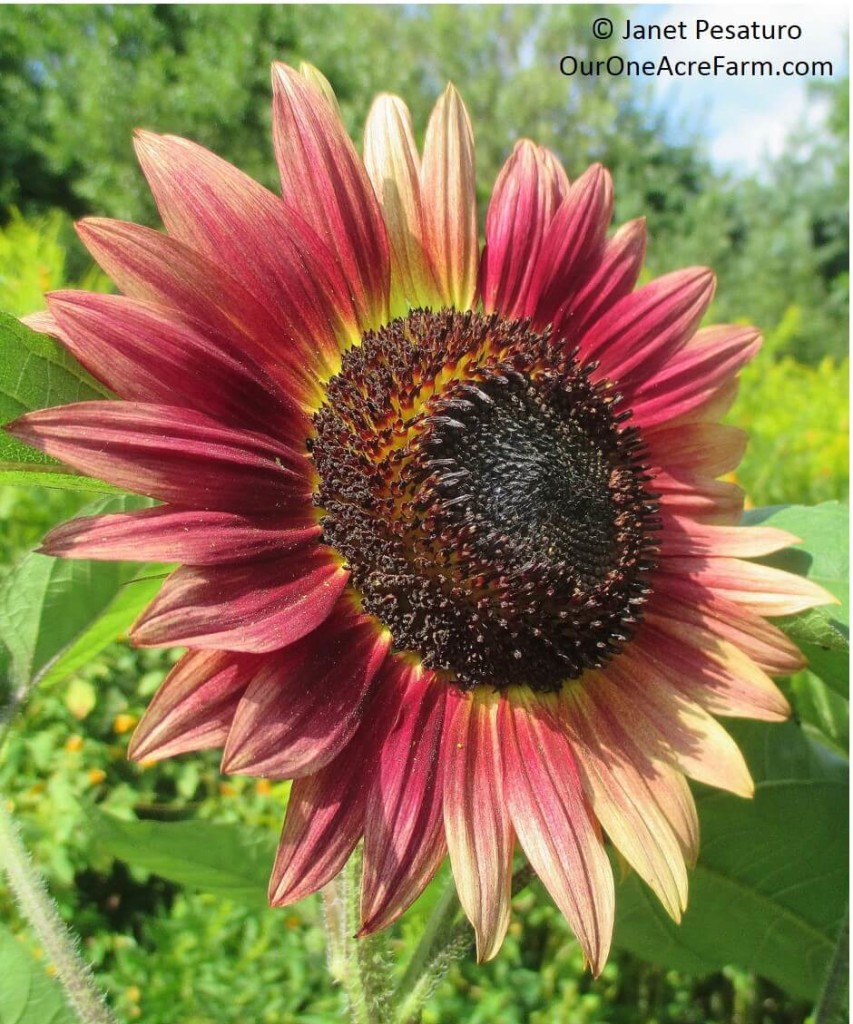
A spectacular deep red sunflower from the mix Autumn Beauty
Sunflower pests and diseases
The fact that the sunflower is native to North America explains why pests are rarely a serious problem. It co-evolved with over 150 species of insects which feed on some part of the sunflower plant, and over 100 species of predatory and parasitic insects which prevent outbreaks of the pests. So unless an exotic pest with an appetite for sunflowers makes its way to North America, you’re not likely to have overwhelming problems in the backyard. At the same time, there are occasional serious problems, and frequent minor problems. Here are some tips for thwarting them:
- Rotate the crops to minimize problems with soil borne fungal diseases such as Sclerotia, which causes sudden death or wilting.
- Grow sunflowers among other flowers, herbs, and vegetables, which helps maintain a balance of insects and other disease organisms. To understand how plant diversity prevents pest outbreaks, read the sections on “Species Diversity” and “Balance” in my article on Permaculture Principles.
- If you have problems with wind borne fungi, such as Ascospore, the best strategy is to grow disease resistant hybrids.
- Bt (Bacillus thuringiensis) might help fight caterpillars like sunflower moths and borers.
- Various leaf spot diseases might cause unsightly patches, but aren’t usually an overwhelming problem. My sunflowers almost always show sign of leaf spot, but overall the plants remain attractive, in a rustic sort of way, and productive.
- Aphids feed on sunflower plants by draining liquids from the undersides of leaves. They usually aren’t a serious problem…unless ants find them. Ants like the sticky, sweet “honeydew” that aphids produce. Like humans, ants farm their livestock: they protect the aphids from predators and spread them around, helping them multiply. A combination of aphids and ants on sunflowers could thus become a serious problem, causing leaves to discolor and dry up. Deter ants with a sticky trap collar below the first set of leaves, and blast aphids with a garden hose.
Good companions and bad companions: Allelopathy
Notice that I just recommended growing sunflowers among other flowers, herbs and vegetables. This might conflict with what you’ve read about sunflowers. They produce allelopathic compounds, which can inhibit the growth of other plants. But a plant’s ability to produce allelopathic compounds depends on its genetics and the environment. Different sunflower cultivars produce these compounds in different quantities, and the amount produced by a given cultivar varies depending on environmental conditions. What are the chances that the variety you choose will produce a significant quantity under the conditions in your garden? Hard to say….
So I don’t pay a whole lot of attention to allelopathy, or to the “rules” of companion planting in general. The reason is that living systems are complicated, with so very many factors influencing how well any given plant grows. Unless you’re doing a lot of testing, documenting, and controlling a plant’s environment, many of the specific rules of thumb probably don’t apply. I simply aim for diversity, for lots of different species growing together, because that tends to prevent any one factor from having an overwhelming influence. So, our sunflowers get rotated near any and all other crops we grow.
Here are a few of many exceptions to the rules that I’ve observed. Pole beans and potatoes are said to suffer when grown near sunflowers, but I haven’t found these rules of thumb to be true. Last year my sunflowers rubbed elbows with my pole beans, and we enjoyed a fantastic pole bean yield. Peppers are sometimes said to benefit from nearby sunflowers, but last year our peppers were also next to the sunflowers and did horribly.

A Mammoth Russian sunflower packed with developing gray striped seeds.
Harvesting seeds
We are usually content to share our sunflower seeds with our chickens and with wild birds, but if you want to harvest them for yourself, cover the seed heads with a paper bag or mesh onion bag. The time to do this is when the petals are dry and falling off, the center florets are drying up, and the seeds begin to swell. Once the seeds develop a hard shell, all the petals have fallen off, and the backside of the flower head has turned yellow or brown, cut the stalk, leaving at least a foot of stalk on the head. Remove the seeds by rubbing them over a wire mesh, or scraping with a spoon. If you are very patient, you can put a paper bag over the flower head and wait for the seeds to fall out on their own. Air dry them, and store in a rodent proof container.
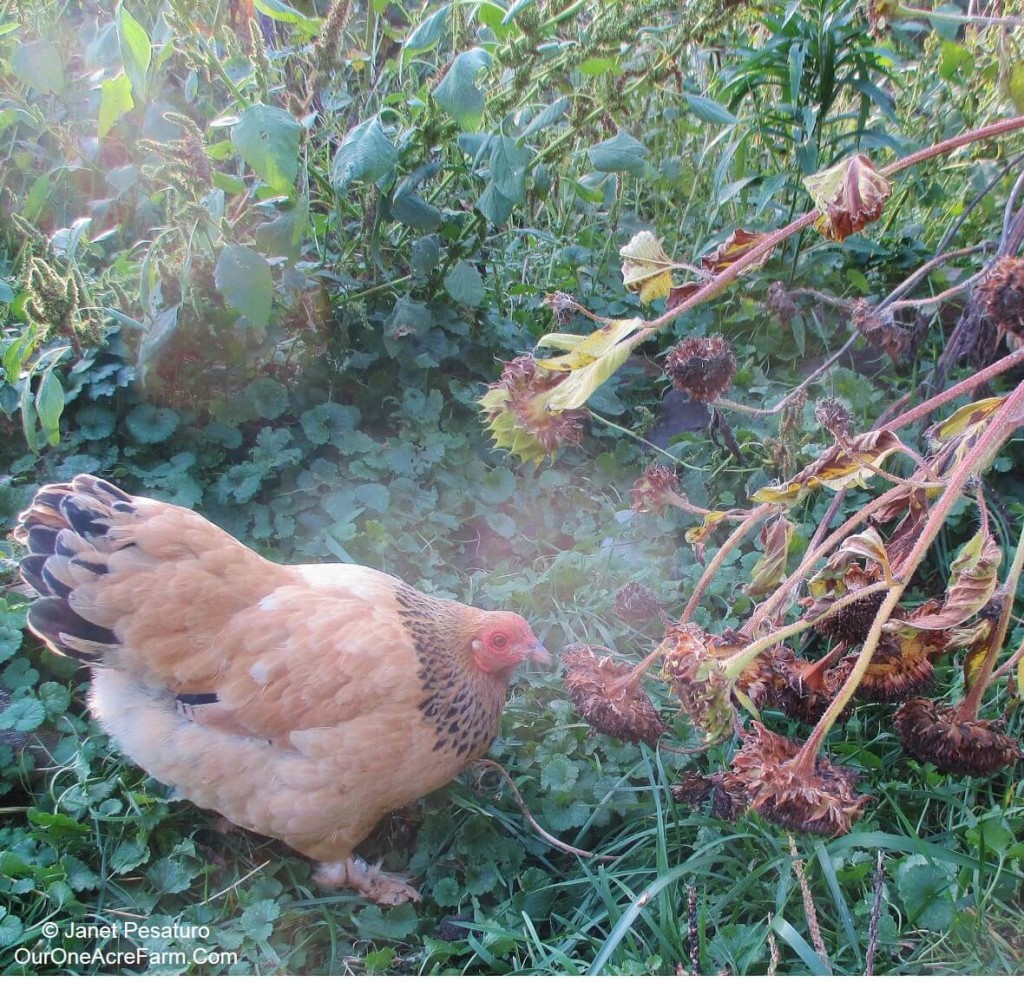
One of our bantam hens enjoying the seeds from a toppled Autumn Beauty sunflower
Sources:
- Ants Raising Aphids on Sunflowers (from Home Guides)
- How to Grow Giant Sunflowers
- How to Harvest Sunflower Seeds
- Michalak and Peterson. 1993. Rodale’s Successful Organic Gardening: Vegetables. Rodale Press, Emmaus, PA.
- Nikneshan, P. et al. 2011. Allelopathic potential of sunflower on weed management in safflower and wheat. Australian Journal of Crop Science. 5(11): 1434-1440
- Sunflower: An American Native, from University of Missouri Extension (history)
- Sunflowers, from the University of Minnesota Extension (doubles)
- Sunflower Pests and Problems
- Sunflower Revolution: New Sizes, Colors, and Varieties for Every Garden











Thank you so much for addressing the companion planting issue. You’ve given me hope. I actually hadn’t heard the theory until I was showing this year’s garden plan off to my readers. Many told me that having sunflowers in the vegetable garden is a huge no-no. It seemed like a great solution to me, with the beautiful soil. Now I’m excited to go for it.
Glad it was helpful, Jess. Let us know how your vegetable garden does this year, with the sunflowers. I’ve been rotating sunflowers around with my other vegetables for at least 15 years now, and haven’t seen anything to support the common claims about what does well and what does poorly growing with sunflowers. If you were to plant a large swath of just pole beans and sunflowers, the beans might suffer, but in an ordinary backyard garden with a variety of plants in the garden, it doesn’t seem that the sunflowers have much of an impact.
Thank you for the informative post. I am one who has never had much luck with sunflowers but I can tell I didn’t give them the care they needed. Looking forward to trying again in my short season climate. The tip about starting seeds outside before last frost was especially helpful.
Glad it was helpful, Sheri. It should help to plant the seeds early. Right now I have a foot tall volunteer sunflower seedling, and the last frost date here in Mass. is late May! It must have germinated over a month ago.
This is a great resource! I would just be on the look-out for “pollenless” varieties of sunflowers. Many seed companies–Johnny’s included–are carrying numerous varieties of pollenless sunflowers aimed at growers of cut-flowers, since that is what those growers want. Pollenless sunflowers are not ideal for pollinators who rely on the pollen as their source of protein, as well as the nectar that flowers provide.
Yes, I said that under “sunflower varieties” – look for “male sterile varieties” (which are pollenless), where I said exactly what you said. But thanks for commenting!
Do you have to protect sunflowers from deer always or just while they are tinny plants? You don”t mention much about deer. And we have deer and turkeys.
Hi Rachel, I don’t know for sure. We have a lot of deer, too, but they have never touched our sunflowers. I do have a friend who says deer ate all of sunflower plants when they are little, but I’m not sure if deer stop eating them when the plants reach a certain size/toughness. Our garden is surrounded by a 4 ft fence. Theoretically, both deer and turkey (and we have a lot of turkey, too) have no trouble getting over a 4 ft fence, but maybe they don’t think it’s worth the effort, or maybe they have enough wild food.
I had deer watching my sunflowers until they were just about to burst forth with those beautiful, happy disks of bright yellow…and the deer would chow down on the flowers. Next night, they would work on the stems, which were a good 2″ in diameter. Eventually, there would be left only a sad little stump where there shoulda, coulda, woulda been a gorgeous 5-6 foot tall sunflower. Sigh. Funny, they didn’t bother with the tender young plants..
That’s interesting information, Kristen, and surprising! I’m not sure why deer haven’t touched our sunflowers. Maybe they just have enough food that they like better.
I have a sunflower patch with 12 heirloom variety. I want to save seeds to plant for next year. Will they be true to type next year since they are not isolated? Thanks for a very helpful article!
Hi Rob,if they are not isolated from each other, and if the flowers of different varieties were open at the same time, the offspring will not be true to type. But if you have any varieties that bloomed when none of the others were blooming and releasing pollen, its seeds should be true to type.
Did royal hybrid reach 7 feet
Royal Hybrid reaches about 7 feet until the heads get heavy, causing them to nod, which makes the plant look shorter. Last year I grew both Royal and Mammoth Russian, and once again, Royal outproduced the other (though MR got much taller)
I think I know the answer to this but want to be sure. I want to grow sunflowers for seeds for the birds. I need to stay away from pollenless types, correct? No pollen, no seeds??
Hi Debbie, a pollenless variety might produce seeds if there is a pollen producing variety growing nearby, because bees can carry pollen from one variety to another. But if you want to be sure of good seed production for either wildlife or yourself, it would be better to grow a pollen producing variety. In my yard the birds have really loved Autumn Beauty sunflowers.
Good article
Thank you, Roxanne!
I’ve never grown sunflowers before but have a tray full of sprouted Manmoth seedlings. I’m going to plant them across our back fence as a privacy screen. After the flowers dry up will the stalks dry up too or will they come back?
Yes, sunflowers are annuals, so when the flower dies, the stalk and leaves will, too. You’d have to replant it every spring to use it as a fence.
You may have some volunteers but don’t be confuse by them, they are new plants grown from dropped seeds
Thank you for the great post! I’ve been planning to grow few varieties of sunflowers and finally got all the seeds I need. Your advises and tips are of a great help for me. Thank you for sharing! Happy gardening!
Glad you found it useful. Good luck with your garden!
My Mammoth Sunflowers were planted in a cardboard egg carton. The wind scattered them across my back porch, but I quickly repotted them in a larger pot. I saved 5 of 6. Once they grew about twice as much as when I repotted them, they got some kind of spider infestation. The larva were sucking my plant’s leaves dry. I sprayed them with soapy water, which they did not like, but they have seemed to recover. Baby leaves had to be nipped because they turned yellow and brown, but new leaves are lush. Occasionally, I’ll pluck off a dinner guest that is “bugging” them (like ants or a gnat), but Im very diligent about checking for red spots (larva).
Question: At what height will my mammoths present a bud?
There’s so much stem and so little leaves on my plants. They’ve been through so much, I feel like the plants and I are trying to convince each other to have faith in their growth lol.
Karen, the height at which they will bud depends greatly on growing conditions. In poor soil, suboptimal sun exposure, and/or inadequate water, they will not grow very well, might not be very tall at maturity.
Janet,
Thanks for all the great information!
I have about 10 or 11 American Giant Hybrid sunflowers in an enclosure to protect them from wildlife in our backyard as we live near a canal in South Florida. If they are 2.5 feet high (28 days since planting) do you think they are beyond the size where an iguana, squirrel or rabbit would eat the leaves? My enclosure is large enough to allow for about another 9 inches of growth but I don’t want to stunt their growth. Thanks, John
John, I know nothing about iguanas, but I strongly doubt rabbits or squirrels would eat the leaves at this point. At least I have never seen them do it when the plant was that mature. However, squirrels will climb the plant and eat the seeds when they are ready.
Janet,
Thanks for the response. My sunflowers have grown another foot and a half since I emailed you! Can I share some experiences?
Iguanas eat sunflower leaves. I chased them away about 4 times over 4th of July weekend. I put cayenne pepper on some of the leaves and it burned a hole through several of them. Brown ducks sampled our buffet today as well. So far I have used wooden stakes and pvc to support them…until what height will they need support and is there a material i.e. wood, pvc, etc.you recommend? I have 8 healthy plants. Thanks, John
John, if pvc and wood stakes have worked well in the past, then go ahead and use what you wish. I use lengths of rebar with metal pipe slipped over the rebar, because we had those materials on hand. The rebar helps keep the stake erect, because it’s easy to push it deep into the soil, but the lengths we have are not tall enough for the sunflowers, which is why we slip the pipe over it.
Hi, you mentioned that you fertilize with your chicken hay. I to have chickens and have thought about this. Do you spread the hay after the seeds have sprouted and grown a certain height? I am getting ready to plant my next crop. We have a long growing season here in North Florida. Thank you!
I’m not that scientific about exactly when I spread it, but sometime after they are at least a few inches in height, so it’s easy to spread it without burying them.
Thanks for sharing so complete guide for planting sunflower. I really looooooove sunflower. So every year I try to grow some in the yard. But no matter how hard I try to protect them, they’re always eaten by the critters. Some of them already 15cm’s height, but still couldn’t survive, all leaves were eaten. Ever bought the grown-up plants with little sunflowers, the next several days, even the flowers were all gone! Really frustrating!
Janet,
Thanks for the earlier responses!
We’re on day 50 since planting and some of our American Giant Hybrids are 7 feet tall with beautiful emerging flower heads that open a little more every day! However, I just noticed what appear to be buds forming directly in the place where some of the branches emerge from the stalks. Is this normal? Did I do something to cause this? I added some slow release fertilizer to the ground before planting so I wonder if this could have something to do with this strange, additional growth.
Hi John, I doubt it’s anything you did. Some varieties have more of a genetic tendency to branch than others. I’ve seen it from time to time even in varieties that were bred to produce only 1 large flower.
Janet,
We’re on day 63 of our American Giant Hybrid Sunflowers and trying to figure out if they are ready to harvest…the backs of the flower heads are green but the petals are falling off and changing color from yellow to gold/brown. We can see the black seeds around the perimeter of several of the flower heads. We appreciate your advice so far and just don’t want to lose all of our seeds to the squirrels and birds (They already have their own feeder).
Thanks, John
Your site looks interesting and very detailed. I grew a single 7 foot sunflower I (don’t know variety as it was given to me) with a single head that is about a foot across. The wind has stripped it of petals now. I wondered what I should do with it (ie I’ve seen people take the heads off and dry them). Of course, I could leave it to wither and dry where it stands and, no doubt, birds would see it and come to feed. I’d also like to grow a few of these again next year – what would you suggest, please? Thanks.
Hi Mike, I’m not sure what you’re asking. Are you asking how to dry the seeds? If so, see the final paragraph of the post. Are you asking for advice on what variety to grow next year? Lots of choices. I prefer Royal hybrid for large striped seeds for eating, and either Autumn Beauty or Evening Sun for seeds for the birds.
I want to grow a acre of sunflowers to sell in my citrus store in south Florida. I want to grow ones with low pollen residue do you recommend one?, where should I buy seeds?, and can I grow them in a row that is from east to west ? does it matter?
Pingback: Guide to Growing Sunflowers – One Acre Farm – Internet Marketing 101
Hi, is there a way in which I could grow the largest seed size on my sunflowers? Would changing anything like watering, or the side dressing (N-P-K) to provide more “P” to help flowers delvelope larger seeds in the flower head? Or is there anything else that you could suggest? thanks for your comments,
Mike Capp
12-14-2016
I want to start a sunflower farm. I don’t have land yet so is it okay to grow them in containers? How big should the containers be and how many seeds to a container? I want to use the sunflowers for birdseed.
We have orange pumPkin looking pods growing on our sunburst sunflowers can you tell us what they are ? We live on the golden Coast
Hello Janet
I am an aspiring Microgreen farmer and was would like to perchase some seed from you in he near future, would you like to help me out?
Thank you very much
-Jim
Pingback: Make DIY Seed Bombs | DIY Seed Balls | Garden Gifts | Stony Ridge Farm
REALLY good information in this article. Thank you very much! I’m an avid grower of sunflowers, but in pots, and even after many years of growing them and trying to understand them, this article has informed me of many things I always wondered about. Cheers!
Hi, Janet!
I’ve never grown sunflowers before and wanted to try to grow some for bird feed. I’ve checked other sites and they said that the sunflowers need to cross pollinate. Does that mean that I need to grow another variety of sunflower or more than sunflower of the same kind? I’m just using the sunflower seeds in the bird feed (I think those are black oil sunflower seeds) and I also have Mammoth Russian in case. They’re just seedlings right now.
Thank you.
what is genetics for branching and non branching varieties of Sunflower ?
what is genetics for branching and non branching varieties of Sunflower ?
Sunflower Virus-bud necrosis resistance gene are available to develop virus resistant hybrids—?
Sunflower virus-bud necrosis resistance gene are available to develp the virus resistant hybrids ?
Hi,can you tell me when I need to plant sunflower seeds so they would bloom in Sept.for a wedding? I live in Mt Pleasant,MI.
Thank YOU.
Kathy
I would have liked to “right click” your page and PRINTED it!
Is there a way for me to print it?
Is pelletized lime recommended for sweetening the soil?
I don’t know if pelletized lime is recommended. I disabled the copying and printing functions because people were stealing my posts and publishing them as their own. I guess you’d have to take screen shots and print those.
I have started some dwarf seeds in little compostable seedling trays but the leaves are starting to yellow and some are curling and starting to shrivel. What do you think is going on?
Thank you for your advice on growing sun flowers. I always have tough time growing
sun flowers. Always started them under a grow light in doors now that i read your article
very interesting and informal. I live in Massachutts. Now i know to start them
directly out side.
Thank you
i thank you very much, Hope to hear from you soon.
Hi!
I saved some royal hybrid seeds from Johnny seeds to replant next year. Is that possible or are they only for eating?